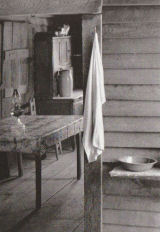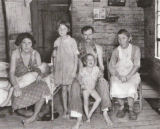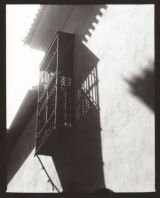Thomas Weber - Photography
The work of walker evens has had a crucial influence on me. From my point of view the image ‘Farmer´s kitchen, Hale County, Alabama of 1936’, shows a perfectly illuminated room rendered beautifully in the photography. A closer view reveals that the towel is hanging on a simple nail, and that it is a poor cottage made out of planks. Only at this point does the poverty becomes obvious. In another picture we see the perfect portrait of a family at home: haggard faces look back at us, contrasted by a laughing child. This child has not understood the misery it has been born into. A reality that it is unlikely ever to escape. Walker Evans, like other artists, was commissioned by the Farm Security Administration to document the disastrous living conditions in the mid west during the Great Depression. It was felt that through this work the public would be moved not to accept these inhuman living conditions. The famous story of "Grapes of Wrath" written by John Steinbeck in 1939 is about this plight and was translated into a movie by John Ford one year later. Interestingly, William Christenberry, who had been friend with W. Evans, later visited the same locations, documenting them now in color. What is telling is that work shows the same calamity, as if little changed.
Since I first realized the complexity of Walker Evans´ photos, I have grown to admire its subtle criticism of social inequality.
Walker Evans was part of a wave of New Realism in the USA. Another member, Ansel Adams, impressed me somewhat earlier in my photographic studies. Adams, well known as the most famous landscape photographer from the USA, developed the Zone System in the early 1940s. This technique was designed to help the photographer achieve their pre-imagined photo by using precise methods for calculating the exposure (another inventor of the Z.S. was Fred Archer). Digging into that Zone System I was fascinated by the incredible technical quality I could now reach, and that impacted on my work. I started to respect the simple elements within my photographs.
The next impetus to spurn me along my creative path was from the poets of the Realismo Mágico, the representatives of the magic realism in the realm of Latin American art. The first in line had been Miguel Ángel Asturias. In his "Men of Maize" ("Hombres de Maíz", 1949) he connected the visible reality with the myths of the Maya Indians of Central America. And he did this almost by creating a new kind of reality. Gabriel García Márquez, a nobel prize winner has the reputation as one of the best writers in the Spanish language and but for me it was Carlos Fuentes who gave me a decisively new impulse with his tale of Chac-Mool (the name of the rain god of the Mayas). When I read the last words of Chac-Mool I understood in a magical way that there exists an invisible enigmatic world that I have now come to accept.
There are a lot of photos on my website of southern Spain. What motivated me to turn towards Andalusia was the historical novel "Shadows to the Pomegranade" (1992) by Tariq Ali. He describes the fall of Al-Andalus that caused a mobilization of the Muslim world to take care of Andalusia. Granada, the last Muslim realm in Spain had been handed over to the Reyes Catolicos in 1492 (so called Catholic Kings, Fernando de Aragon & Isabella de Castilla). Through this shift the unique and relatively peaceful coexistence of Muslims, Jewish and Cristians came to an end, eroded by progressively developing radicalism on both sides.
The Photo in the box on the right side shows a balcony in the Albaycin, the antique, Arab heart of Granada. At first the atmospheric interference of light and shadow might impress. but there is more.; A barred balcony with the bars narrowly spaced. What is it that covers the bars and their shadows making them appear as one? The answer is revealed through the oriental origin of this former metropolis. The ambiguous forms reflect the principle of the Harem, to see and not to be seen. In this manner what is revealed is a Moorish past still living, majestically, in present day Al-Andalus.
These influences have had a marked impression on my creative outlook.
Ansel Adams showed me the potential for technical perfection and a respect for simple things. Walker Evans taught me how to use multi-layered expression, while the authors of the Realismo Mágico revealed a bridge between visible and hidden realities.
P.S.: There is a Bibliography concerning these topics in "Links & Bibliography".
© Thomas Weber 2010 - 2025


